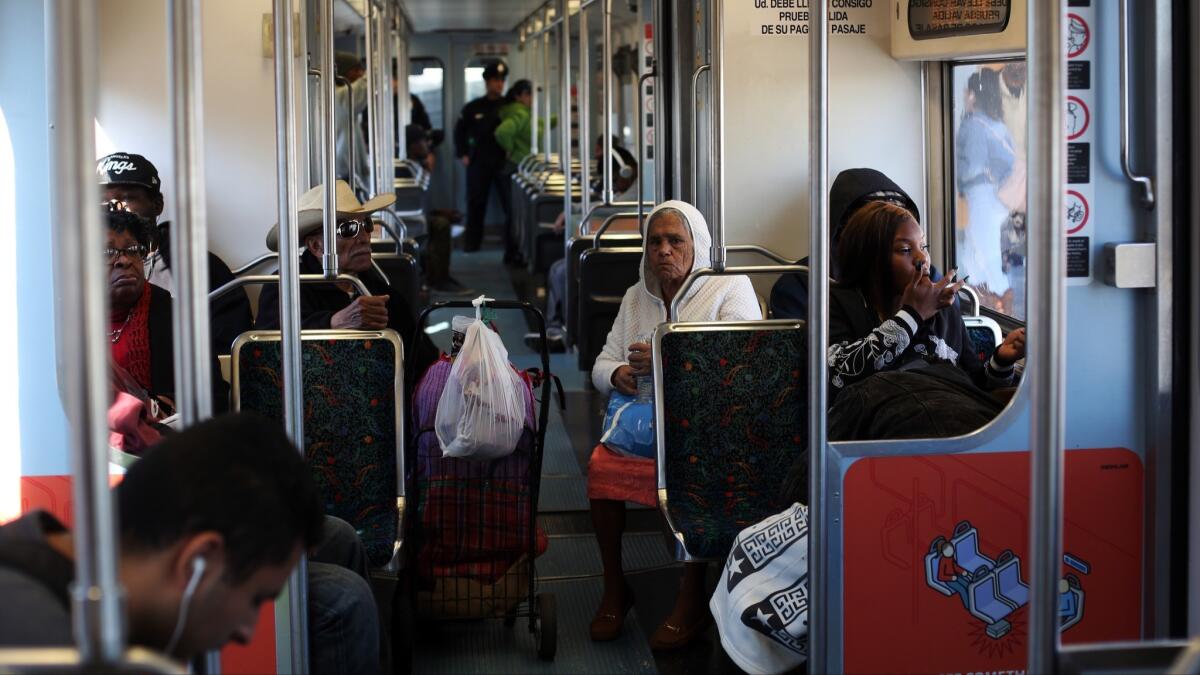Delays, crowding and technical problems plague Metro’s newly reopened A Line

- Share via
When Los Angeles County’s oldest rail line reopened this month after a 10-month closure, transportation officials threw three parties, including one emceed by Snoop Dogg.
Clad in a navy-blue tuxedo, the rapper lauded the $350-million overhaul of the Blue Line, now called the A Line, saying the route had a “new name with some new tricks.”
Two hours after the celebrations ended, a signal problem near downtown L.A. triggered a series of delays. In the three weeks since, the line has seen more than two dozen delays linked to rail cars, gate crossings, overhead power lines and the signal system.
Frustrated riders who endured shuttle buses, long waits and a closure that went on a month longer than advertised say that so far, the A Line’s new tricks feel just like the old ones.
“As if the 10 months of no train wasn’t inconvenient enough, it’s just been weeks of total ineptitude,” said Julian Milward, 37, an attorney who lives in Long Beach and commutes to downtown. “It’s really discouraging.”
Before the closure, the 29-year-old line was showing its age. Metro renovated much of its infrastructure, replacing and improving portions of the signals, tracks and the overhead power lines. Stations got new lighting and fresh paint.
Even with the opening delayed by a month, construction continued right up to the deadline. That left “little to no time” for testing before passenger service resumed, said Chief Operations Officer James Gallagher.
“We did not have enough time to do an adequate amount of testing,” Gallagher said. “It was whatever we could squeeze into the time available. It was not long.”
Before opening a new line, Metro typically spends at least a month running empty trains on the tracks to find and fix any problems. Such testing on the A Line lasted 30 hours, spokesman Brian Haas said.
Metro conducted more than 14,000 hours of testing while the new systems were being installed and brought online, enough for the line to be safely opened, Haas said. But another week, he said, “would have been beneficial.”
A major source of delays, Gallagher said, stemmed from problems with the A Line’s power system.
Light-rail trains are powered by a device called a pantograph, sometimes shaped like a metal arm, a diamond or a triangle. The pantograph is designed to skim the wires that run above the line, collecting electricity that powers the train.
The wires were installed too low in five locations, Metro said. Part of the overhead power system began to strike the pantographs, damaging the carbon strips that conduct electricity, Gallagher said.
Half of the trains in the A Line’s fleet were damaged and had to be repaired, Haas said.
Metro is also still working to fix a crossing gate at 108th Street and Willowbrook Avenue, where the arms are coming down too slowly before trains cross the intersection. Until the gate is fixed, Gallagher said, trains must stop at the crossing.
“We’re keenly aware of what we promised, and where we’ve got to work our little fingers to the bone to get there,” Gallagher said.
When Metro officials announced the closure, they said the improvements would shave 10 minutes from the travel time between Long Beach and Los Angeles, reducing a 58-minute trip to 48 minutes.
Metro’s new schedules show a travel time of 53 minutes, five minutes faster than before — but that doesn’t always hold true, riders say. The delays and technical issues have caused unreliable travel times.
“We didn’t have to go out there and make the assertions that the times are going to improve, but we did,” Metro board member and Duarte Councilman John Fasana said this month. “If we’re going to make a public commitment, we need to be prepared to keep it.”
Metro Deputy Executive Officer Anthony Crump said the “primary purpose” of the A Line renovation was “not necessarily a time reduction” but to make service more reliable.
Worn down by the delays, some riders have resorted to gallows humor, taking bets on the time of the next breakdown. Others have turned to a Facebook group in which more than 400 riders commiserate and share tips.
“We haven’t had those moments that were like, ‘The closure was worth it,’” said Natalie Hernandez, 28, of Long Beach, who founded the group. “It kind of sucks, because people have this first impression that the line isn’t working, and first impressions are a big deal.”
So far, Milward said, he’s taken three rides on which nothing went wrong. One morning this month, he arrived at the station to find delays so severe that he asked to work from home — an option many riders don’t have.
“I’m going to be late again,” said Armando Soto, 22, as he waited for an A Line train last week. Emergency maintenance had caused delays of more than 20 minutes during rush hour, leaving platforms packed.
Soto was headed to an evening shift as a security guard at a downtown office tower. Long waits ate into the time he could use to study for his college classes, he said, and his tardiness had put him on thin ice with his boss.
“I thought it was going to be better than this,” he said. “What was all the construction for?”
More to Read
Sign up for Essential California
The most important California stories and recommendations in your inbox every morning.
You may occasionally receive promotional content from the Los Angeles Times.











